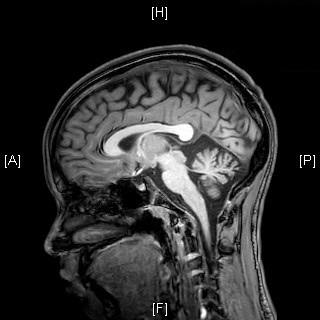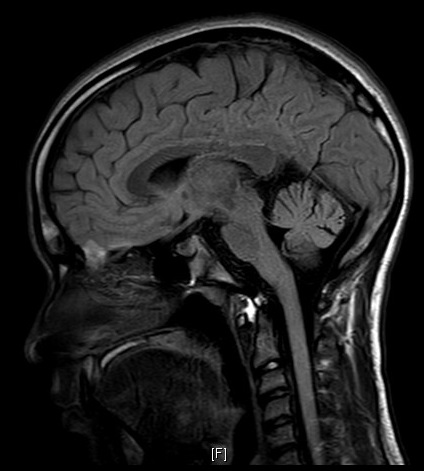Category: Ataxia
Objective: To report the therapeutic effects of amantadine in a patient with Spinocerebellar ataxia type 7 (SCA7)
Background: Spinocerebellar ataxia type 7 is a rare autosomal dominant disorder characterized by progressive cerebellar ataxia and retinal degeneration resulting in blindness, a unique feature amongst the dominantly inherited SCAs. The disease is caused by expansion of a polyglutamate (CAG) repeat within the SCA7 gene in the chromosome 3p, which encodes a protein named ataxin-7. The phenotypic expressions may vary widely based on the CAG repeat count and age of onset, an expansion of > 37 CAG repeats is pathogenic. SCA7 displays variable penetration and marked anticipation of both onset age and rate of progression. To date, there are no approved medications for the treatment of this condition; however there are a variety of possible targets for ataxia treatment.
Method: We report a 16-year-old male with progressive visual loss since age 12 followed by dysarthria, limb and gait ataxia, shuffling gait to the point of requiring a walker. He was evaluated by an ophthalmologist who diagnosed him with rod-cone dystrophy. MRI brain at age 13 showed mild diffuse cerebellar atrophy. Genetic SCA panel detected 64 CAG repeats in the SCA7 gene, confirming the diagnosis of SCA7. He had no known family history of vision loss or ataxia.
Results: The patient presented to our institution at age 16. Exam revealed decreased visual acuity, slow saccades, limited vertical gaze, severe dysarthria, appendicular ataxia, dysmetria and adiadochokinesia. He was wheelchair-bound and was not able to stand without assistance. The Scale for the Assessment and Rating for Ataxia (SARA) score was 37. Amantadine 100mg daily was initiated and after 4 weeks of treatment patient and family members reported significant improvement, especially in truncal ataxia. SARA score at that time was 31, indicating an improvement of 16%. Subsequently, amantadine was increased to 100mg twice daily. A follow up visit is pending.
Conclusion: Amantadine, an antiglutaminergic medication, has been reported to have mild-to-moderate improvement in symptoms of ataxia and parkinsonism in patients with ataxia telangiectasia. This is the first case reporting improvement of ataxia in a patient with SCA7. This report suggests that amantadine may be useful in the treatment for ataxia in patients with SCA7. Further large-scale studies are needed to confirm these results.
References: 1. Sarva H, Shanker VL. “Treatment Options in Degenerative Cerebellar Ataxia: A Systematic Review.” Movement Disorders Clinical Practice 1.4 (2014): 291–298 2. Michalik, A., Martin, J. & Van Broeckhoven, C. Spinocerebellar ataxia type 7 associated with pigmentary retinal dystrophy. Eur J Hum Genet 12, 2–15 (2004). 3. Margolesky J, Carbunar O. A Representative Case of Spinocerebellar Ataxia Type 7. Neurology Apr 2019, 92 (15 Supplement) P1.9-047 4. Gurusidheshwar MW. “Spinocerebellar Ataxia Type 7: Report of an Indian Family.” Annals of Indian Academy of Neurology 16.4 (2013): 708–711. 5. Walker M, Farrell D. “Spinocerebellar Ataxia Type 7 (SCA7).” Practical Neurology 6.1 (2006): 44–47 6. Youn J, Shin H, Kim JS, Cho JW. Preliminary study of intravenous amantadine treatment for ataxia management in patients with probable multiple system atrophy with predominant cerebellar ataxia. J Mov Disord. 2012;5(1):1–4. doi:10.14802/jmd.12001 7. Nissenkorn, A et al. “Movement Disorder in Ataxia-Telangiectasia: Treatment With Amantadine Sulfate.” Journal of Child Neurology 28.2 (2013): 155–160 8. Garden G. Spinocerebellar Ataxia Type 7. 1998 Aug 27 [Updated 2012 Dec 20]. In: Adam MP, Ardinger HH, Pagon RA, et al., editors. GeneReviews® [Internet]. Seattle (WA): University of Washington, Seattle; 1993-2020
To cite this abstract in AMA style:
L. Pesantez Pacheco, N. Thakur. Amantadine Therapy for Ataxia Management in Patients with Spinocerebellar Ataxia Type 7 [abstract]. Mov Disord. 2020; 35 (suppl 1). https://www.mdsabstracts.org/abstract/amantadine-therapy-for-ataxia-management-in-patients-with-spinocerebellar-ataxia-type-7/. Accessed April 21, 2025.« Back to MDS Virtual Congress 2020
MDS Abstracts - https://www.mdsabstracts.org/abstract/amantadine-therapy-for-ataxia-management-in-patients-with-spinocerebellar-ataxia-type-7/


